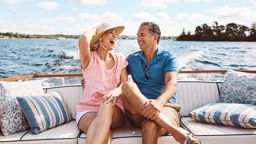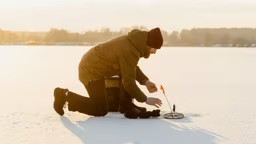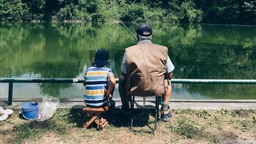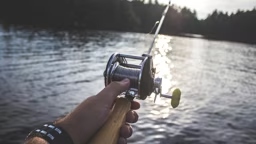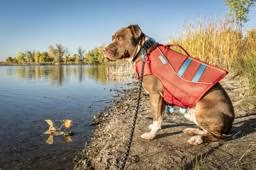
The 5 types of PFDs
The Coast Guard classifies PFDs into five types, but most cabin owners who boat on calm, inland waters will only need Type II or III. The archaic bright orange foam-filled PFDs are Type II PFDs, and are good in a pinch for a quick rescue, but they are bulky and uncomfortable to wear. Try an inflatable Type II PFD. Or, follow advice from the National Safe Boating Council. It recom-mends inland boaters should wear Type III, which can be foam-filled or inflatable, and are available in many styles, colors and sizes.
“The good news is that manufacturers are listening to the boaters, and the boaters are recognizing that not just one type (of PFD) works for each boating activity,” says Rachel Johnson, National Safe Boating Council executive director. “So now manufacturers are realizing that if they offer comfortable life jackets that fit specific boating activities, boaters are going to want to wear them.”
Johnson suggests that the Type III PFD gives you the “most multi-activity option” for boating activities. “You want to always look for one that is U.S. Coast Guard approved,” she says. “That is the number one priority.
Type I PFDs are for rough, open or remote waters where rescue may take a while. These have the most buoyancy. Type IV are throwable devices like cushions or ring buoys. Type V includes hybrid inflatables, with a performance equal to Types II and III, but they’re geared for special uses and must be used for the activity specified on the label.
Who should use a PFD?
Who will be using the PFD and how it will be used determines which style of life jacket you should pick out for your family members. Johnson notes higher quality Type III jackets are now available in colors and styles that are appealing and comfortable for women. MTI Adventurewear offers four models of form-fitting Type III vests for women, including the PFDiva with an adjust-a-bust fit system.
A variety of companies such as Stearns, O’Brien, Stohlquist WaterWare and MTI Adventurewear offer Coast Guard-approved PFDs for children and infants. When buying a PFD for infants, Johnson recommends selecting a model with a crotch strap and a back cushion that has a handle on it. “Make sure you buy a life jacket for kids that fits them now,” Johnson says. “It is not like a pair of shoes that they are going to grow into. It needs to fit them at that time. Another idea is to let them pick it out. So if it has one of their favorite cartoon characters or colors, they will be more willing to wear it rather than complain about wearing it.”
See also PFD Standards Are Changing
Different Uses for a PFD
Here’s a look at Johnson’s PFD recommendations for the following boating activities
Kayaking/Canoeing
Inflatables are an excellent option for paddling on smooth waters, but Johnson recommends a foam-filled jacket if the waters have some chop. Astral manufactures three great recreational kayaking PFDs that are Coast Guard approved. The V-Eight is a breathable jacket with an air flow system that keeps paddlers cool in hot weather, has a mesh back that’s cut to fit the high-seat backs of recreational kayaks, and has extra-wide arm cutouts so paddlers can take angled paddle strokes without rubbing against the jacket. The company’s Linda model has pre-shaped foam to better fit women kayakers while the Ronny model has similar features as the Linda but offers a better torso fit for men. Waterskiing/Wakeboarding
Waterskiing/Wakeboarding
Johnson endorses Type III vests for this, and she notes manufacturers are designing stylish and lightweight specialty brands. “You have to be careful when picking these out because some are not Coast Guard approved,” she warns.

Fishing
“If you are on calm water, we love to recommend the inflatable life jacket,” Johnson says. “It is such a comfortable lightweight option, that a lot of anglers and hunters are willing to choose it.”
I frequently use this style of vest because it allows me to move my arms freely while casting and setting the hook on fish. And its smaller profile makes the PFD cooler to wear in hot weather. Johnson suggests that Mustang Survival makes great inflatable models for fishing, such as the M.I.T. 100, which the company claims has more than 1.5 times the buoyancy of most foam PFDs.
For fishing in rough water, a foam-filled life vest such as the Stearns Flotation Fishing Vest offers an “extra level of security,” according to Johnson. I personally like fishing with this style of vest in the cold weather because the foam filling adds insulation to warm the core of my body, and the wider arm cutouts provide more room for the various arm movements required to catch fish and operate a boat.
You’re a strong swimmer and you have life jackets stowed on board, so why should you have to wear one?
The life jacket gets in your way when you’re trying to cast your rod or paddle your kayak, and it’s too hot to wear in the summertime. Besides, wearing one of those old-fashioned orange life preservers makes you look like a nerd.
These are some of the excuses I hear boaters use for not wearing a life jacket when out on the water, but there’s one important reason why they should always wear a personal flotation device (PFD). The U.S. Coast Guard reported in 2012 that 85% of drowning victims in recreational boating accidents were not wearing a life jacket.
For more helpful information on PFDs, visit safeboatingcampaign.com.
RESOURCES
- MTI Adventurewear, mtiadventurewear.com
- Stearns, stearnsflotation.com
- O’Brien, obrien.com
- Stohlquist WaterWare, tohlquist.com
- Mustang Survival, mustangsurvival.com
- Astral, astraldesigns.com



